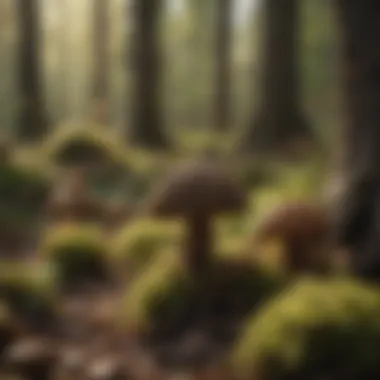When to Seek Morel Mushrooms: A Comprehensive Guide


Intro
Foraging for morel mushrooms is not merely a pastime; it is an art form imbued with the understanding of nature's rhythm. These temperamental fungi thrive in specific conditions, which makes knowing when to venture out crucial for success. The morel's life cycle intertwines with various environmental factors, including temperature, moisture levels, and the type of habitat. This guidance aims to equip both seasoned foragers and eager beginners with the knowledge necessary to recognize the optimal times for morel mushroom hunting. By doing so, individuals can foster a deeper appreciation for these remarkable organisms and the ecosystems in which they flourish.
Identifying the right moments to seek morels is a complex task. It goes beyond simply considering the calendar dates and leans heavily on understanding the unique interplay between weather, geographical location, and ecological conditions. The subsequent sections will dissect the intricacies involved in the search for morel mushrooms, providing insight into suitable times for foraging, key environmental requirements, and localised variations that can alter the foraging landscape dramatically.
Foreword
The pursuit of morel mushrooms is an endeavor that goes beyond mere culinary delight. These unique fungi hold a prominent place in foraging culture, representing not just a source of nutrition but also a connection to the natural world. Understanding when to seek them is vital for both amateur foragers and seasoned mushroom hunters alike. This article aims to provide a thorough examination of the factors influencing morel growth and availability, delving into seasonal patterns, environmental conditions, and geographical variances.
By grasping the complexities surrounding the hunting of morels, readers can improve their foraging skills and enhance their overall experience. When one comprehends the crucial timing for seeking morels, it not only increases the likelihood of actually finding them but also fosters a deeper appreciation for their ecological role.
Moreover, exploring environmental indicators such as soil conditions, flora associations, and weather patterns will facilitate a more informed approach to foraging. In essence, this section sets the stage for a comprehensive guide that allows individuals to navigate the intricate world of morel mushroom foraging with confidence.
Understanding Morel Mushrooms
Morel mushrooms are fascinating organisms belonging to the Morchellaceae family, recognizable by their distinctive honeycomb appearance. They are highly sought after, not just for their taste, but also for their unique texture, which can enrich a variety of dishes. Morels thrive in specific conditions and their fruiting is closely tied to environmental cues.
Their lifecycle is characterized by a range of growth stages, starting from a network of mycelium in the soil, which forms the foundation for their development. Conditions such as temperature and humidity play essential roles in stimulating their emergence. Generally, morels prefer moister climates and well-drained soils rich in organic matter. Understanding their biology and growth requirements helps foragers to identify optimal locations and times for collecting these prized mushrooms.
As you prepare to explore the nuances of morel hunting, keep in mind that each detail regarding their habitat and lifecycle can drastically influence your success. Thus, a thorough understanding of morel mushrooms will not only enhance your foraging abilities but also lead to a more rewarding experience in nature.
The Lifecycle of Morel Mushrooms
The lifecycle of morel mushrooms is a core aspect of understanding when and where to find them. Knowing how these fungi grow and develop not only informs foragers about their availability but also serves to enhance the overall foraging experience.
Morels undergo several key stages of growth, each with its own unique environment and conditions. Recognizing these stages helps foragers predict fruiting times, which can vary based on various factors like climate, soil conditions, and seasonal weather patterns. This knowledge not only increases the potential yield when foraging but also fosters a deeper appreciation for the natural world, and its patterns and cycles. Understanding the lifecycle also aids in conservation efforts, as it is essential to foraging sustainably and responsibly.
Maturation Stages
The maturation stages of morel mushrooms progress through several distinct phases. Initially, morels begin as tiny spores that germinate under suitable conditions.
- Mycelial Growth: Once the spores land in a hospitable environment, they develop into mycelium, which is a network of fungal threads that can penetrate the soil. This stage is crucial for nutrient absorption and can last for months or even years before fruiting occurs.
- Fruiting Body Formation: After sufficient growth, environmental conditions—such as temperature and moisture—trigger the development of the fruiting bodies, which are the morel mushrooms we seek. This stage typically occurs in the spring, aligning with warm, moist conditions.
- Maturation of the Fruit: As morels mature, they develop their distinctive appearance. They can grow rapidly, often reaching full size within a few days. During this stage, it is essential to monitor the mushrooms closely, as their edibility can varies based on visual cues.
- Spore Release: Once mature, morels release spores to begin the lifecycle anew. This spore dispersal typically occurs in late spring to early summer, marking the end of the season for that year.
Recognizing where the morel mushroom is in its lifecycle is invaluable for any forager. By understanding the maturation stages, you can optimize your foraging strategy and timing, ultimately resulting in a more successful and rewarding experience. This knowledge will also allow you to respect the ecosystem, preserving favorable conditions for future generations of morels.
Seasonality: A Key Factor
Understanding the role of seasonality in foraging for morel mushrooms is fundamental to success. The growth cycle of these fungi is closely tied to specific seasonal conditions. Knowing when to seek morels can significantly impact the yield of your foraging efforts. Weather patterns, temperature fluctuations, and humidity levels all play a critical role in determining when these mushrooms will appear.
Being aware of these seasonal factors not only increases the chances of finding morels, but it also fosters a deeper appreciation for their delicate life cycle. Morels thrive in response to changes in environmental conditions, and recognizing these cues helps foragers align their outings with the natural rhythms of the fungi.
Spring: The Prime Season
Spring heralds the prime foraging time for morel mushrooms. As the days start to warm and the last remnants of frost wane, the conditions become ideal for these fungi to emerge. Typically, morels begin to appear in late March to early June. The specific timing can vary based on local climates, but understanding the average temperatures and soil conditions can increase the likelihood of a successful hunt.
In many regions, the ideal temperature for morel growth hovers around 60°F to 70°F. Rainfall also plays a crucial role, as moist soil provides the necessary environment for morels to flourish. The arrival of warm air following spring rains is often a key indicator that morels are ready for picking, making early morning foraging after rainfalls particularly fruitful.
"Catching the peak timing in spring is essential for maximizing your morel harvest."
Summer: A Secondary Opportunity
While summer is not the primary season for morels, it can still present a chance for harvesting these mushrooms. As temperatures rise, the likelihood of finding them decreases, but some areas may offer a late crop of morels. Typically, these summer morels are smaller and less abundant than their spring counterparts.
For strategies during this time, focus on shaded areas where humidity remains higher. Riversides and orchards can often provide the needed shelter from the heat. It is also essential to monitor soil moisture and temperature. If conditions remain favorable from late spring through early summer, foragers may still find some elusive morels. Patience and persistence are key during this season.


Fall and Winter: Off-Season Considerations
The fall and winter months generally mark the off-season for morel mushrooms. During this time, most mushrooms retreat underground, leading to minimal foraging opportunities. However, understanding this off-season can still be beneficial for aspiring foragers.
During the fall, other types of mushrooms may be harvested, offering a chance to learn about different species and their habitats. Winter, while harsh for morel hunting, encourages foragers to research and prepare for the upcoming spring season.
Keeping track of environmental changes during these months, such as soil temperature and moisture retention, can provide valuable insights for the next foraging season. Knowing when to expect morels again allows foragers to strategize and gear up effectively, ensuring they are ready when the prime season arrives.
Climate Considerations
Understanding the climate conditions that affect the growth of morel mushrooms is crucial for successful foraging. These mushrooms thrive under specific environmental influences that can determine both their availability and quality. Insights into climate factors such as temperature, humidity, and precipitation not only help foragers locate these mushrooms but also enhance the overall foraging experience. Recognizing these elements allows individuals to plan their trips effectively, increasing the chance of harvesting fresh morels.
Temperature and Humidity Requirements
Morels prefer a temperate climate. The ideal temperature for their development typically ranges from 50°F to 70°F (10°C to 21°C). When temperatures remain within this range, the conditions are most conducive to morel proliferation. It's important to note that extreme temperature variations can hinder growth.
Humidity also plays a significant role in morel development. Morels require moist soils to thrive. Therefore, humidity levels of over 80% are often seen as ideal. This combination of temperature and humidity creates a suitable microclimate for the fungi, promoting optimal growth.
Monitoring local weather patterns can provide significant insights into the suitability of conditions for morel hunting. In addition, understanding how temperature fluctuations occur during the day can assist in identifying times when foraging may be most productive.
Precipitation Patterns
Precipitation is another critical factor influencing morel production. They flourish in moist environments, which makes regular rainfall essential during the growing season. Consistent rainfall, especially in spring, leads to a higher density of morels. Soil moisture levels are directly affected by rain, impacting the mushrooms' nourishment and growth.
In general, a minimum of 1-2 inches of rain over the two weeks preceding a foraging trip is beneficial. Heavy showers can provide sufficient moisture for the ground, but excessive rainfall can lead to waterlogged soils, hindering mushroom growth. By examining precipitation forecasts, foragers can plan their excursions during or shortly after wet weather for the best results.
An understanding of climate factors significantly enhances the ability of foragers to find morels successfully.
In summary, temperature and humidity requirements along with precipitation patterns form the backbone of morel mushroom growth. By paying attention to these climate considerations, aspiring foragers can increase their chances of a successful outing, enhancing both the quality and quantity of their harvest.
Regions and Geography
Understanding the geographical context of morel mushrooms is essential for successful foraging. Their growth depends on a variety of environmental elements unique to specific regions. By examining these regional variations, members of the forestry community can enhance their foraging strategies and ultimately increase their chances of finding these prized fungi. The interplay between climate, soil composition, and local flora adds complexity to when and where to seek out morels.
The significance of regions is twofold. Firstly, different climates provide varying seasonal windows for mushroom growth. Knowing these timings helps foragers plan their trips more effectively. Secondly, the native vegetation supports the development of morels. Recognizing the associations between certain trees and morel mushrooms guides foragers toward potential hotspots. Hence, the geographical understanding of the terrain helps refine the search process.
Moreover, each region possesses characteristics that affect not only the timing but also the types of morels that may be available. Variations in soil type, moisture levels, and temperature ranges dramatically influence growth patterns. The continued observation of these elements allows foragers to adapt their methods for optimal success.
Northern Regions: Timing Differences
In northern areas, the growing season for morel mushrooms is significantly shorter. Typically, morels in these regions will start appearing in late April to May, depending on the weather conditions. The cooler temperatures create a unique microclimate conducive to the growth of morels, often nestled in forests where afternoon sun can penetrate.
Key timing differences in northern regions include:
- Frost Events: The risk of late frosts can delay the appearance of morels. Foragers should always check the local forecast.
- Soil Temperature: Morels thrive when the soil temperature reaches around 50°F. Monitoring soil temperature can be beneficial.
- Vegetation Influence: The decaying leaves of hardwood trees contribute organic material vital for morel growth.
Careful observation of these factors enhances success rates amongst foragers in more northern climates.
Southern Regions: Unique Characteristics
Southern regions present a different set of challenges and opportunities for foragers. Morel mushrooms here can begin to appear as early as March and may last through June. The milder temperatures along with increased humidity foster a more prolonged season.
Unique characteristics of southern regions include:
- Diverse Ecosystems: Southern regions often contain a wider variety of habitats where morels flourish. Notably, they frequently appear in oak and pine-dominated forests.
- Increased Competition: Early foraging in southern areas can lead to higher competition from other foragers. Thus, timing and location become pivotal.
- Variable Rainfall: Rain patterns can significantly impact growth; too little or too much rainfall can hinder the success of the foraging season.


In summary, understanding the distinct characteristics of northern and southern regions is crucial for effective morel hunting. Knowledge about seasonality and environmental preferences tailored to each geographic area enhances foraging opportunities, enabling those passionate about mushroom hunting to refine their skills and expeirence.
Foraging Techniques
Foraging techniques are crucial when searching for morel mushrooms. Understanding these methods can greatly increase the success rate of mushroom hunters. By employing specific strategies, foragers can enhance their ability to locate morels while minimizing risks associated with improper identification and environmental issues. This section will focus on identifying ideal locations and timing your foraging trips.
Identifying Ideal Locations
Identifying the right locations is key to finding morel mushrooms. Morels thrive in certain ecological conditions. They often grow near specific types of trees. For example, look closely around ash, elm, and oak trees. These trees provide the right nutrients and habitat conducive to morel growth.
In addition to tree proximity, consider the health of the surrounding ecosystem. Healthy environments support larger populations of morels. Areas that have experienced recent disturbances, such as forest fires, can also yield abundant harvests. The soil type plays a role as well. Well-draining soils are typically fertile for morels. Sandy or loamy soils are often ideal.
To effectively identify these locations, foragers should:
- Scout locations early. Visit potential sites before the typical season starts to observe the environment.
- Document your finds. Keep records of where mushrooms were located in the past to identify patterns.
- Join local foraging groups. Collaborating with experienced foragers can provide insights on the best spots.
"Finding morels often requires patience and familiarity with their habitat."
Timing Your Foraging Trips
Timing is essential when foraging for morels. Seasonal changes can impact mushroom growth significantly. The best time to hunt is generally in spring, particularly around mid to late April. However, the exact timing can vary based on geographic location and annual climate variations.
In addition to seasonal timing, consider the time of day. Early morning or late afternoon is typically the best for foraging. Temperatures tend to be cooler, making the search more comfortable. Furthermore, during these times, the natural light can illuminate the mushrooms better.
Keep an eye on recent weather patterns as well. Morels often appear after a rainy period, especially when followed by warmer temperatures. Observing local forecast trends can help in predicting the optimal foraging times.
To summarize, successful foraging directly relates to both location and timing. By understanding these aspects, foragers can significantly improve their chances of locating morel mushrooms.
Environmental Indicators
The study of environmental indicators is critical for anyone interested in foraging for morel mushrooms. These indicators provide essential information about the ecosystem's health and the conditions suitable for morel growth. Recognizing these signs can greatly enhance the foraging experience for both novice and seasoned mushroom hunters.
Flora Associations
The relationship between morel mushrooms and other plant species forms a vital aspect of foraging. Morels tend to grow in association with specific trees and plants. Common partnerships include species like elm, ash, and apple trees. Understanding these associations can dramatically increase the chances of finding morels.
When searching for morels, look for areas with heavy leaf litter and decaying wood. These environments, particularly those accompanied by flowering plants in the spring, often indicate a suitable habitat. Some foragers keep an eye on certain grasses and plants that thrive in the same ecosystem as morels.
Additionally, considering the overall health of the flora can give clues to soil health. Healthy plants often indicate more favorable conditions for mushroom growth, so areas teeming with diverse plant life should be carefully examined.
Soil Conditions
The quality of the soil is another crucial factor. Morels prefer well-drained, loamy soil that is rich in organic matter. Soil pH can also play a role; morels thrive in slightly acidic to neutral soils. Conducting simple tests can help determine if the soil conditions are right for foraging.
When evaluating soil conditions, select areas where the soil temperature ranges around 50-60°F, which typically coincides with the spring season. Morel mushrooms tend to fruit after the soil has warmed adequately, following a period of significant moisture.
Furthermore, look for soil that visibly retains moisture without being overly saturated. Compacted or dry soils generally do not support morel growth.
"Understanding the intricacies of soil and flora associations can make a marked difference in the success of your foraging efforts."
Optimal Times for Foraging
Understanding the optimal times for foraging morel mushrooms is crucial for any serious forager. It can mean the difference between a fruitful day in the woods and returning empty-handed. The timing is influenced by various factors, such as weather patterns and lunar cycles. Recognizing these elements helps one determine when to venture out.
Weather Patterns and Their Impact


Weather plays a vital role in mushroom growth. Morels thrive in conditions where ground temperatures are aligning with specific moisture levels. Ideally, morels begin to emerge when soil temperatures are around 50 to 60 degrees Fahrenheit. This typically coincides with springtime thawing.
The combination of warm days and cooler nights, along with adequate rain, promotes optimal growth.
In addition to temperature, moisture is fundamental. A good rainfall prior to foraging season ensures that the ground remains damp, facilitating the sprouting of morels. As a general rule, check the weather forecast for rain a few days before heading out. However, too much rain can lead to saturated ground, which is unfavorable for morel growth. Therefore, understanding local weather patterns is vital.
- Foragers should monitor:
- Temperature trends over the weeks leading to the season.
- Rainfall levels, concentrating on storms followed by dry spells.
It is prudent to keep a foraging log to understand seasonal trends in specific locations.
Moon Phases and Fungal Growth
Lunar cycles can also influence morel mushroom growth, though the connection may seem obscure at first. Many seasoned foragers believe that the full moon offers optimal conditions for mushroom hunting. The idea is that fungus is more likely to emerge during full moon phases due to the increased light at night.
Research supporting this idea is limited, yet anecdotal evidence keeps this tradition strong among mushroom hunters. For instance, a common practice is to plan trips around the new moon to full moon period to catch the peak emergence of morels.
To summarize:
- Morels tend to grow during the full moon.
- Foragers may find success planning foraging trips aligned with lunar cycles.
By integrating weather patterns and moon phases into the schedule, foragers increase their chances of securing morels. This knowledge transforms the foraging experience from mere luck to a strategic endeavor.
The End
The conclusion serves as the culmination of the exploration into foraging for morel mushrooms, encapsulating the key arguments made throughout the article. Understanding the optimal time to seek out these mushrooms is vital for both novice and seasoned foragers. Through the integration of diverse factors such as seasonal patterns, environmental indicators, and regional characteristics, foragers can significantly enhance their success rates in locating these elusive fungi. The importance of the topic lies in its potential to foster a deeper appreciation for morels, culminating in a greater respect for the ecosystems in which they thrive.
Summary of Key Insights
The insights gathered from this comprehensive guide can be summarized as follows:
- Seasonal Awareness: Morel mushrooms are primarily a spring phenomenon, requiring a keen awareness of the seasonality to ensure successful foraging trips.
- Climate Influence: Both temperature and humidity are crucial in determining when morels will appear. Warm springs with adequate moisture levels significantly boost growth.
- Regional Differences: Geographical location plays a significant role. Northern and southern regions exhibit distinct timing and characteristics in morel proliferation, necessitating tailored strategies for foragers.
- Environmental Indicators: Knowledge of the flora associated with morels, along with understanding soil conditions, helps identify potential foraging sites.
- Optimal Foraging Conditions: Weather patterns and even lunar phases can affect growth. Observing these conditions boosts the chances of finding morels.
"The key to successful foraging for morel mushrooms lies in timing, location, and environmental awareness. Embrace knowledge to enhance your foraging journey."
As you embark on your foraging adventures, remember the interplay of all the discussed elements. Each expedition becomes an opportunity to connect with nature while harvesting these distinctive mushrooms.
Importance of References
References serve multiple purposes. First, they consolidate expert knowledge on morels from various disciplines, ensuring that the forager is informed about the specific species, their habitat, and thriving environments. Second, utilizing scholarly articles or botanical texts could improve confidence in identifying morels versus lookalikes that might be toxic.
Furthermore, having access to varied resources will allow foragers to adapt their strategies based on personal locations and climatic conditions. This adaptability is crucial as the natural world is constantly changing and knowing when to pivot one's approach can make all the difference in foraging success.
Benefits of Using Reliable References
- Establishes a solid foundation of ecological understanding.
- Increases safety in identifying edible mushrooms.
- Keeps foragers updated on regional variations and seasonal changes.
Considerations
However, not all information is equal. Secondary sources might lack the accuracy or expertise needed for safe foraging. Therefore, prioritizing primary studies, authoritative texts, and contributions from recognized mycologists is vital. Engaging with community platforms such as Reddit or Facebook groups dedicated to mushroom foraging can complement formal education.
It is essential for foragers to keep learning and stay connected with other enthusiasts. Continuous education fosters a sustainable appreciation for morel mushrooms.
Further Reading and Resources
By tapping into research papers, academic databases, and textbooks focused on mycology, foragers can deepen their understanding. Some recommended resources include:*
- Wikipedia on Morel Mushrooms
- Encyclopedia Britannica
- For community insights, engaging with platforms like Reddit can also be quite beneficial.
Compiling this information offers a clearer perspective and enhances the overall foraging journey.



